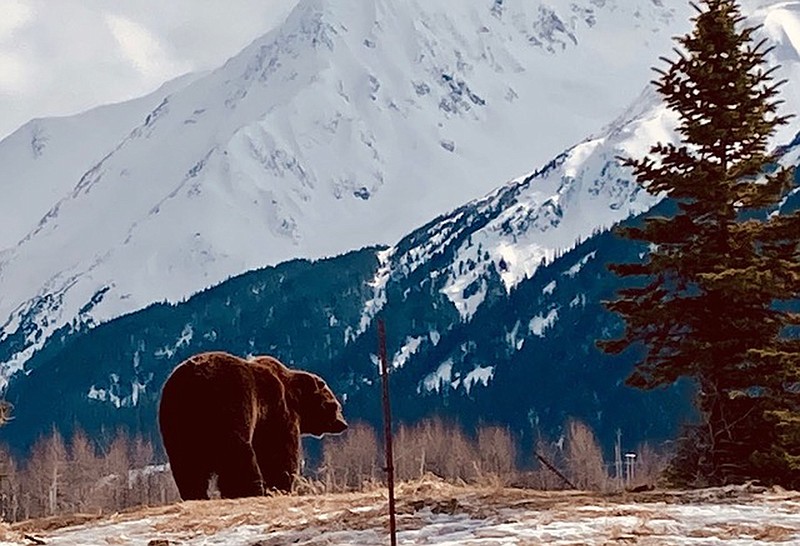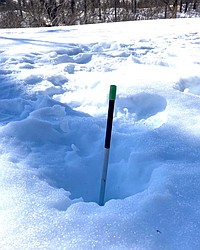ANCHORAGE, Alaska -- Fire hydrants in Anchorage are taller than most, but they put tall reflective poles on them so firefighters can find them in the snow.
They put poles on bridge guardrails, too.
Western Alaska is a cold, snowy place, even in early April when snow is still at least 5 feet deep in places and the temperature is in the teens. An Arkansas guy is not used to those kinds of conditions in the springtime, but it was appropriate for one of the most starkly rugged, most beautiful places I've seen.
My son Ethan hatched this idea after scoring a superb package deal that included airfare, lodging and rental car for him, his brother Matthew and me for $1,600. We hopped a flight to Denver from Little Rock on Monday, and then shoehorned ourselves in the back of a packed United Airlines Boeing 737 for a five-hour flight to Anchorage. In the row behind us were three members of the Hell's Angels from Rhode Island. Listening to their conversation livened up the flight considerably.
The temperature was about 25 degrees on arrival, and we refueled with a superb meal at Simon & Seafort's, a fine restaurant downtown that rates as having the best seafood in town. From there we took a long walk on a trail at a city park that winds along a wide tidal flat on Cook Inlet. There I met a young man who, with the freedom of working remotely for a cybersecurity firm, relocated from Wyoming to a city that is described as a smaller version of Seattle. For him, the attraction is the outdoor lifestyle and boundless outdoor recreation opportunities. His love for the place was effervescent.
Photo Gallery
Alaska Images
Bryan Hendricks captured these majestic images of the 49th state during a visit to western Alaska April 5-9.
[Gallery not loading above? Click here for more photos » arkansasonline.com/411alaska/]
We ate breakfast the next morning at a chain restaurant. Our server was a woman from Chattanooga, Tenn., who moved to Anchorage 20 years ago.
"I'm an Alaskan now," she said cheerily. "Ain't no way I'll ever leave."
As we traveled south toward Seward, the mountains grew higher, and there was a lot more snow. Our destination was a series of glaciers in the Chugach National Forest, the most prominent being Portage Glacier. In the late 1800s, gold miners arriving at Prince William Sound crossed the perilous Portage Glacier to reach the Turnagain gold fields. The glacier was much larger and taller then, having shrunk and receded from warmer temperatures.
My sons and I first walked to the terminus of Byron Glacier on hard-packed snow that was about 3 feet deep. You were fine as long as you stayed on the heavily trodden part of the trail, but if you strayed, you'd punch through to your waist.
Ethan and Matthew wore Yaktrax metal coil attachments on their shoes for traction. I wore Lowa Nabucco Evo GTX boots. It is an extreme cold weather boot with a Vibram Arctic Grip Trac II that is said to grip ice and snow. It works precisely as advertised and allowed me to walk effortlessly on slick ice that melts and re-freezes daily. We followed wolf tracks, and I kept a can of bear spray in a holster on my belt.
Next, we visited Portage Glacier and actually walked the entire length of Portage Lake, which is still frozen. Walking the lake was about 4 miles round trip. The first leg was pleasant with a 30-mph wind at our backs, but with the wind in our faces, the return leg was very tedious.
The day's last stop was the town of Whittier, a port on Prince William Sound. This is probably the weirdest place I have ever visited. To get there, you pay $13 to go through a dank, narrow 2.5-mile tunnel that was blasted through a mountain. It is primarily a railway tunnel with one-way traffic. Vehicles are spaced about 100 yards apart, and the speed limit is 25 miles per hour. Traffic is allowed only once an hour, and then a giant metal door closes over the tunnel entrances. You drive on the railroad track and straddle them when possible. There are seven "safe houses" in case of a cave-in. It is the only convenient route to Whittier from Alaska Highway 1. The only other route goes over the mountains and takes hours.
All of the residents of Whitter live in two buildings. One is a colorful high-rise apartment building. The other building is the equivalent to the "wrong side of the tracks."
That day's refueling stop was at Yamaya Seafood in downtown Anchorage. It is a tiny, one-man operation. Three other people were there. One was a businessman that travels the world. He is so fond of Yamaya's and visits so often that he has photos of the entire menu on his smartphone. The various sashami options were artistic, to say the least.
Beside us was a young North Carolina native, a chef who has been all over the world. His stories were fascinating, told with an irresistible, world-weary ennui. He spoke of campfire cooking in the Peruvian mountains and complained about it being illegal to chew gum in Singapore. His date was a young Canadian woman who had studied photojournalism.
The meal was truly a communal affair, partly from necessity. The proprietor of Yamaya prepares each dish individually, and it takes a long time. Matthew and I shared marinated king salmon and king crab roll, which we received about 90 minutes after we ordered and 30 minutes after the establishment officially closed. However, the owner never locked the door. This is not a complaint. The food, the company and the entire experience was delightful.
On Wednesday, we traveled to Seward and boarded the Orca Song for a whale-watching tour in Resurrection Bay. The weather was fair and the sea was calm, but whales eluded us. However, we saw up close big pods of Dall's porpoises, which look like baby orcas. We also saw coastal mountain goats feeding on near vertical slopes.
Black-legged kittiwakes tended to eggs in the merest cracks in cliff walls. The captain said that the kittiwakes spend winter at sea and return to the coast in the spring, where they lay their eggs on south-facing crags that receive full sunlight. While he spoke, an immature bald eagle swooped and snatched a kittiwake from the water among about 300 other kittiwakes, the ultimate example of random bad luck.
Occupying an entire rock among this menagerie was a colony of stellar sea lions, whose population has declined by about 90% since the 1970s. The captain offered several theories, the most plausible being that warming surface temperatures have driven the small fish on which they feed deeper than stellar sea lion pups can dive.
"They have lots of babies, and they do really well until they are weaned," the captain said. "After they wean, they don't do well."
At this time, Alaska is experiencing spring "breakup," when wind and warming temperatures break up the ice and open the waterways. Unfortunately, no fish were in season during this visit. When snow melt swells the creeks and rivers, salmon will migrate upstream to spawn, turning the state into an angling paradise. The landscape will be awash with spring color, and wildlife will be active everywhere, including downtown Anchorage, where moose roam the streets.
For me, this was a long-awaited chance to cross another state off my list. I lack only four to visit them all: Montana, Washington, North Dakota and Rhode Island. Now that I've seen it, I will definitely return to Alaska to fish, and maybe even to hunt.
The coronavirus pandemic hit the state's tourism industry hard, so now might be a great time to plan a visit.






